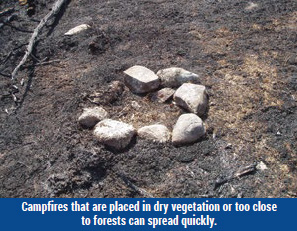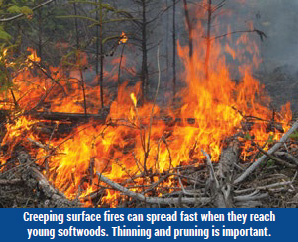Module 16: Wildfire and Your Woodland - Lesson 2 - Case Study 1
The smoke was hardly noticeable until noon. By that time, the last crushed cans had been collected and the straying plastic wraps gathered into a large bag. It was, for all intents and purposes, a cleaned-up campsite, with little to betray the intensity of the previous night’s party.
It had been quite a night. There had been music, in the form of two guitars and a set of spoons, which proved sufficient a the night progressed. There were the few sleeping bags—in the end just enough for the eight teenagers. Greatest of all had been the bonfire, and what a bonfire! The leaping flames had awakened a primitive kind of dance among the party-goers. Those who did not dance sat galvanized, staring into the writhing flames, their senses both dulled and sharpened by the orange firelight.
In the cool, gray May dawn they had woken, laughing, stumbling through the brown-topped grass to hunt the snack bags that had started to scatter with the morning breeze. “Be sure and get everything,” one shouted as they combed the area for litter. The fire, now a blackened mound in a rough stone circle, was forgotten as the two cars roared off.
Tuned to the patterns of the departing campers, blue jays visited the campsite that morning. They shrilly argued over bits of popcorn and a discarded egg sandwich before they too departed. A raven stared down from the top of a tall spruce tree. The breeze was freshening as the big bird caught the next gust and glided away downwind.
|
|
By noon the glowing orange coals, hidden deep in the black pile of ash, had begun to shed sparks. Like tiny seeds, the bright embers scattered just outside the stone circle. They found flammable fuel in the dry stalks of grass and fed slowly until the next gust of wind ignited one into a single small, hungry flame.
In less than 10 minutes, the fie had found new fuel and entered the surrounding softwood forest. The broken top of a balsam fir tee, felled by the last winter’s winds, lay directly in the path of the flames. Old fir cones, still attached to the branches, were covered in dried resin. In seconds, needles, cones, and twigs flared as the tree top was engulfed in a snapping, sparking blaze.
As the fie advanced further into the forest, it found new fuel. The thick moss beneath spruce trees began to smoulder and thick acrid smoke spiraled skyward. A chipmunk, alarmed at this intrusion, didn’t stop to scold as it vanished into a hole at the base of a tree. The low branches of the spruce trees, dry at this time of year, started to smoke.
Where the ground vegetation was thick, some moisture was still present, which slowed the progress of the fie. Damp maple leaves lifted off from the forest floor as the hot air launched them upwards. Some leaves glowed as the breeze pushed them into the forest.
The fie was gaining momentum as the flames, ladder-like, climbed the low shrubs and reached the lowest branches of the spruce trees. The first tee branches erupted in a sparking flash as the tinder-dry needles ignited. Surrounding trees soon caught as the fie crowned and became an inferno of heat. Pushed by the strong breeze, it leaped from tree to tree, engulfing everything in its path. The white smoke could be seen for kilometres as it raced toward a subdivision of dwellings.
The throbbing drone of a helicopter soon joined the roar of the fie. It circled as the crew assessed the speed, direction, and intensity of the fie. Firefighters o the ground deployed at the edge of the subdivision and emergency trucks sped past the startled and fearful homeowners who were being evacuated even as the smoke rolled thickly through their neighbourhood. Hundreds of metres of fie hoses were unrolled and snaked through the trees like giant spider webs, forming a front nearly a kilometre wide. Scores of firefighters race to confront the fie at a narrow woods road just inside the forest. It was there that they would attempt to stop it.
|
|
A larger helicopter with a water bucket joined the first aircraft, jettisoning its load at the leading edge of the fie. Clouds of steam rose as the water smothered some of the flames and the fie’s advance hesitated. The helicopter flew to a nearby lake to refill the bucket. White arcs of spray fanned out through the trees as thousands of litres of water poured through the fie hoses. When hot embers descended through the smoke and onto the roofs of houses, hoses were turned on the houses to keep them from igniting.
The helicopter was relentless in its continuous cycle of refilling and dumping water on the fie. A fuel truck had been positioned in a local ball field for th inevitable moment when fuel began to run low, and the helicopter was not long in returning to its circuit. By early evening, no large flames were visible from the air.
The work on the ground started in earnest as firefighters began the exhausting task of extinguishing hotspots with back tanks and shovels. The entire area of the fie, which had been nearly 20 hectares, would need to be thoroughly combed for signs of smouldering embers. It would be a long night.
|
|
As the helicopters clattered off and evening descended, people began to return to their homes. Most were shocked to see how closely the fie had come to destroying their houses and everything in them. Fire hoses lay everywhere. The hoses still trailed off into the forest, where they would be retrieved the next day.
The home that was closest to the fie received the most damage. It had been continually hosed as the embers from the fie descended on and around it. Thanks to the efficient work y fiefighters, th house had been saved. The family had been evacuated quickly, so quickly that they had no time to collect any belongings. A teenage daughter looked in vain for a blue earring she must have lost while they were scrambling to get to their car. Her father shook his head as he surveyed the damage to the back lawn where a tanker truck had been briefly stuck.
At dawn the next day, the firefighters wee still mopping up hotspots. The local church had provided sandwiches and drinks, and replacement crews were due to arrive shortly. The provincial fie chief had arrived by helicopter to determine the cause of the fie and the extent of the damage. “Set it down here,” he told the pilot.
As he got out of the aircraft, he knew that this site was where the fie had started. A crude ring of stones told the tale of the fie’s beginnings. Perhaps campers or hikers came through here yesterday, he thought. Partiers would probably have left some litter. He kicked at a stone, then bent over and picked up an object from the charred grass. He held it up and caught a gleam of colour from beneath the black soot. A blue earring. He put the evidence in a clear plastic bag and walked back to the helicopter.


